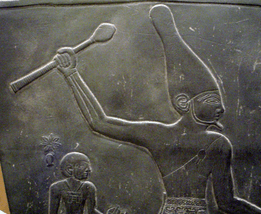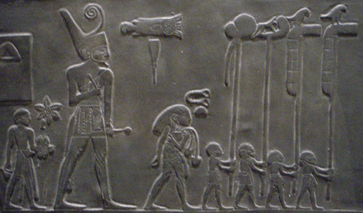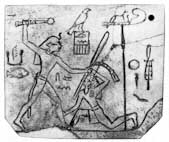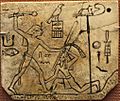Pharaoh facts for kids
Quick facts for kids Pharaoh of Egypt |
|
|---|---|

|
|
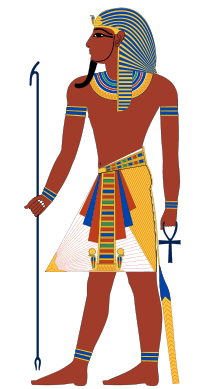
|
|
| Details | |
| Style | Five-name titulary |
| First monarch | Narmer or Menes (by tradition) |
| Last monarch | Cleopatra and Caesarion |
| Formation | c. 3150 BC |
| Abolition | 30 BC |
| Residence | Varies by era |
| Appointer | Divine right |
A Pharaoh was the powerful ruler of ancient Egypt. This title was used for kings and queens from around 3150 BCE until Egypt became part of the Roman Empire in 30 BCE. Interestingly, the word "Pharaoh" itself wasn't commonly used for a ruler until much later, around 1200 BCE. Early Egyptian kings had special titles, like the Horus name or the 'Sedge and Bee' name. More titles, such as the Golden Horus, were added over time.
In ancient Egypt, religion was very important. The pharaoh acted as a link between the gods and the people. This meant the pharaoh was both a leader for the country and a religious leader. Pharaohs owned all the land in Egypt. They made laws, collected taxes, and led the army to protect Egypt from invaders. They also led religious ceremonies and chose where new temples would be built. Pharaohs were responsible for keeping Maat, which meant cosmic order, balance, and justice. Sometimes, this meant going to war to defend Egypt or to get important resources.
Before Egypt was united, Lower Egypt had a "Red Crown" called the Deshret. Upper Egypt had a "White Crown" called the Hedjet. After the two kingdoms joined, the Pschent crown was created. This crown combined both the red and white crowns. Over time, new headdresses were used, like the Khat, Nemes, Atef, Hemhem crown, and Khepresh. Sometimes, pharaohs wore a mix of these crowns and headdresses.
Contents
What Does "Pharaoh" Mean?
The word pharaoh comes from an ancient Egyptian phrase. It is pr ꜥꜣ, which means "great house". This term first referred to the royal palace itself. It was not used for the ruler.
Later, around the Twelfth Dynasty, the phrase "Great House, May it Live, Prosper, and be in Health" appeared. This phrase still referred to the palace. It was only much later that "Pharaoh" became a title for the king or queen.
Pharaoh's Special Items
Pharaohs had special items that showed their power. These items are called regalia.
Scepters and Staves
Scepters and staves were symbols of authority in ancient Egypt. One of the oldest royal scepters was found in the tomb of Khasekhemwy. Kings often carried a staff. Pharaoh Anedjib is shown with a special mks-staff.
The heqa-scepter, also known as the shepherd's crook, is very old. It dates back to prehistoric Egypt. Another important scepter was the was-scepter. This was a long staff with an animal head. It appeared during the First Dynasty. Both kings and gods are shown holding the was-scepter.
The flail was also important. It was often paired with the heqa-scepter, forming the famous crook and flail. Early pictures show kings holding only the flail.
The Uraeus
The Uraeus was a rearing cobra symbol. It first appeared during the reign of Den in the First Dynasty. People believed the cobra protected the pharaoh by spitting fire at enemies.
Crowns and Headdresses
Deshret: The Red Crown
The Deshret was the red crown of Lower Egypt. It is very old, dating back to before the dynasties began. It showed that the wearer was the main ruler. Pictures of Narmer show him wearing the red crown on important artifacts like the Narmer Macehead and the Narmer Palette.
Hedjet: The White Crown
The Hedjet was the white crown of Upper Egypt. Kings like Scorpion II and Narmer wore it in the Predynastic Period.
Pschent: The Double Crown
The Pschent crown combined the red Deshret and white Hedjet crowns. It became the official crown after Egypt was united. The first clear pictures of it are from the reign of Den in the First Dynasty.
Khat Headdress
The khat headdress was like a kerchief. Its end was tied like a ponytail. The earliest pictures of the khat are from the time of Den. It appeared again later during the reign of Djoser.
Nemes Headdress
The Nemes headdress started with Djoser. It is the most common crown seen in pictures of pharaohs. Other crowns were often worn on top of the Nemes. A statue of Djoser shows him wearing the nemes headdress.
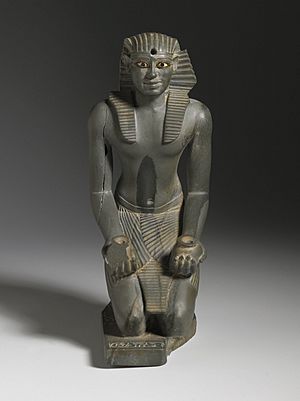
Atef Crown
The god Osiris is often shown wearing the Atef crown. This crown is an elaborate Hedjet with feathers and disks. Pharaohs wearing the Atef crown appear in art from the Old Kingdom.
Hemhem Crown
The Hemhem crown is usually shown on top of other crowns like the Nemes, Pschent, or Deshret. It is a fancy triple Atef crown with corkscrew sheep horns and often two cobras (uraei). This crown started appearing in art during the Early 18th Dynasty.
Khepresh: The Blue Crown
The Khepresh crown, also called the blue crown, appears in art from the New Kingdom. It is often shown being worn in battles. However, it was also worn during ceremonies. While many used to call it a "war crown," modern historians do not use that term.
Missing Crowns
Even though crowns are shown everywhere in royal art, no ancient Egyptian crown has ever been found. Tutankhamun's tomb was mostly untouched. It had his crook and flail, but no crown.
Historians think crowns might have been seen as magical or state property. Perhaps a dead pharaoh could not keep a crown. They might have been passed on to the next ruler.
Pharaoh's Many Names
During the early dynastic period, kings had three main titles. The Horus name is the oldest. The Nesu Bity name was added during the First Dynasty. The Nebty name appeared toward the end of the First Dynasty. The Golden Horus name is not fully understood.
Later, the prenomen and nomen titles were added. These names were usually written inside a cartouche, which is an oval shape. By the Middle Kingdom, rulers had five official names.
The Nesu Bity Name
The Nesu Bity name, also called the Prenomen, was a new development from the reign of Den. This name followed symbols for the "Sedge and the Bee." It is usually translated as "King of Upper and Lower Egypt." This name was often the pharaoh's birth name. It was also the name used in later king lists.
The Horus Name
The Horus name was chosen by the king when he took the throne. This name was written inside a square frame called a serekh, which looked like a palace. The oldest example of a serekh is from King Ka. Early Horus names often showed a connection to the god Horus. For example, Aha means "Horus the fighter." Later kings used their Horus names to express ideas about kingship.
The Nebty Name
The first example of a nebty name is from King Aha of the First Dynasty. This title connected the king to the goddesses of Upper and Lower Egypt, Nekhbet and Wadjet. The title was shown with a vulture (Nekhbet) and a cobra (Wadjet) on a basket.
The Golden Horus Name
The Golden Horus or Golden Falcon name was shown with a falcon on a gold symbol. This title might have shown the pharaoh's divine status. The idea was that gods' bodies were made of gold. Pyramids and obelisks were seen as golden sun-rays. The gold symbol might also refer to Nubt, the city of Set. This could mean Horus defeating Set.
Nomen and Prenomen
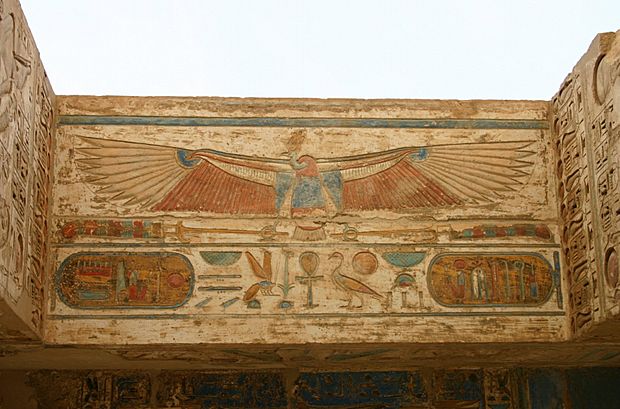
The prenomen and nomen were placed inside a cartouche. The prenomen often followed the title "King of Upper and Lower Egypt" or "Lord of the Two Lands." The prenomen often included the name of the sun god Re. The nomen usually followed the title "Son of Re" or "Lord of Appearances."
Related Pages
Images for kids
-
Ivory label depicting the pharaoh Den, found at his tomb in Abydos, c. 3000 BCE. British Museum, London
See also
 In Spanish: Faraón para niños
In Spanish: Faraón para niños


